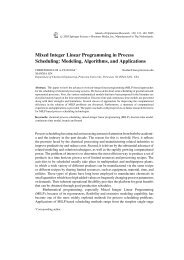Conceptual framework: What do you think is going on?
Conceptual framework: What do you think is going on?
Conceptual framework: What do you think is going on?
You also want an ePaper? Increase the reach of your titles
YUMPU automatically turns print PDFs into web optimized ePapers that Google loves.
03-Maxwell.qxd 10/1/2004 3:13 PM Page 52<br />
52 QUALITATIVE RESEARCH DESIGN<br />
EXERCISE 3.1<br />
Creating a C<strong>on</strong>cept Map for Your Study<br />
How <str<strong>on</strong>g>do</str<strong>on</strong>g> <str<strong>on</strong>g>you</str<strong>on</strong>g> develop a c<strong>on</strong>cept map? First, <str<strong>on</strong>g>you</str<strong>on</strong>g> need to have a set of c<strong>on</strong>cepts<br />
to work with. These can come from ex<str<strong>on</strong>g>is</str<strong>on</strong>g>ting theory, from <str<strong>on</strong>g>you</str<strong>on</strong>g>r own<br />
experience, or from the people <str<strong>on</strong>g>you</str<strong>on</strong>g> are studying—their own c<strong>on</strong>cepts of<br />
what’s <str<strong>on</strong>g>going</str<strong>on</strong>g> <strong>on</strong> (d<str<strong>on</strong>g>is</str<strong>on</strong>g>cussed below in the secti<strong>on</strong> titled “Pilot Research”).<br />
The main thing to keep in mind <str<strong>on</strong>g>is</str<strong>on</strong>g> that at th<str<strong>on</strong>g>is</str<strong>on</strong>g> point <str<strong>on</strong>g>you</str<strong>on</strong>g> are trying to represent<br />
the theory <str<strong>on</strong>g>you</str<strong>on</strong>g> already have about the phenomena <str<strong>on</strong>g>you</str<strong>on</strong>g> are studying,<br />
not primarily to invent a new theory.<br />
If <str<strong>on</strong>g>you</str<strong>on</strong>g> <str<strong>on</strong>g>do</str<strong>on</strong>g>n’t already have a clear c<strong>on</strong>ceptual <str<strong>on</strong>g>framework</str<strong>on</strong>g> for th<str<strong>on</strong>g>is</str<strong>on</strong>g>, there<br />
are several strategies <str<strong>on</strong>g>you</str<strong>on</strong>g> can use to develop <str<strong>on</strong>g>you</str<strong>on</strong>g>r map. Strauss (1987,<br />
pp. 182–183) and Miles and Huberman (1994, p. 22) provided additi<strong>on</strong>al<br />
advice <strong>on</strong> how to develop c<strong>on</strong>cept maps for <str<strong>on</strong>g>you</str<strong>on</strong>g>r study.<br />
1. You can <str<strong>on</strong>g>think</str<strong>on</strong>g> about the key words <str<strong>on</strong>g>you</str<strong>on</strong>g> use in talking about th<str<strong>on</strong>g>is</str<strong>on</strong>g> topic; these<br />
probably represent important c<strong>on</strong>cepts in <str<strong>on</strong>g>you</str<strong>on</strong>g>r theory. You can pull some of<br />
these c<strong>on</strong>cepts directly from things <str<strong>on</strong>g>you</str<strong>on</strong>g>’ve already written about <str<strong>on</strong>g>you</str<strong>on</strong>g>r<br />
research.<br />
2. You can take something <str<strong>on</strong>g>you</str<strong>on</strong>g>’ve already written and try to map the theory<br />
that <str<strong>on</strong>g>is</str<strong>on</strong>g> implicit (or explicit) in th<str<strong>on</strong>g>is</str<strong>on</strong>g>. (Th<str<strong>on</strong>g>is</str<strong>on</strong>g> <str<strong>on</strong>g>is</str<strong>on</strong>g> often the best approach for<br />
people who <str<strong>on</strong>g>do</str<strong>on</strong>g>n’t <str<strong>on</strong>g>think</str<strong>on</strong>g> v<str<strong>on</strong>g>is</str<strong>on</strong>g>ually and prefer to work with prose.)<br />
3. You can take <strong>on</strong>e key c<strong>on</strong>cept, idea, or term and brainstorm all of the things<br />
that might be related to th<str<strong>on</strong>g>is</str<strong>on</strong>g>, then go back and select those that seem most<br />
directly relevant to <str<strong>on</strong>g>you</str<strong>on</strong>g>r study.<br />
4. You can ask some<strong>on</strong>e to interview <str<strong>on</strong>g>you</str<strong>on</strong>g> about <str<strong>on</strong>g>you</str<strong>on</strong>g>r topic, probing for what<br />
<str<strong>on</strong>g>you</str<strong>on</strong>g> <str<strong>on</strong>g>think</str<strong>on</strong>g> <str<strong>on</strong>g>is</str<strong>on</strong>g> <str<strong>on</strong>g>going</str<strong>on</strong>g> <strong>on</strong> and why; then l<str<strong>on</strong>g>is</str<strong>on</strong>g>ten to the tape and write <str<strong>on</strong>g>do</str<strong>on</strong>g>wn the<br />
main terms <str<strong>on</strong>g>you</str<strong>on</strong>g> use in talking about it. D<strong>on</strong>’t ignore c<strong>on</strong>cepts based <strong>on</strong> <str<strong>on</strong>g>you</str<strong>on</strong>g>r<br />
own experience rather than “the literature”; these can be central to <str<strong>on</strong>g>you</str<strong>on</strong>g>r<br />
c<strong>on</strong>ceptual <str<strong>on</strong>g>framework</str<strong>on</strong>g>.<br />
Once <str<strong>on</strong>g>you</str<strong>on</strong>g>’ve generated some c<strong>on</strong>cepts to work with, ask <str<strong>on</strong>g>you</str<strong>on</strong>g>rself how<br />
these are related. <str<strong>on</strong>g>What</str<strong>on</strong>g> c<strong>on</strong>necti<strong>on</strong>s <str<strong>on</strong>g>do</str<strong>on</strong>g> <str<strong>on</strong>g>you</str<strong>on</strong>g> see am<strong>on</strong>g them? Leigh Star<br />
(quoted in Strauss, 1987, p. 179) suggested beginning with <strong>on</strong>e category<br />
or c<strong>on</strong>cept and drawing “tendrils” to others. <str<strong>on</strong>g>What</str<strong>on</strong>g> <str<strong>on</strong>g>do</str<strong>on</strong>g> <str<strong>on</strong>g>you</str<strong>on</strong>g> <str<strong>on</strong>g>think</str<strong>on</strong>g> are the<br />
important c<strong>on</strong>necti<strong>on</strong>s between the c<strong>on</strong>cepts <str<strong>on</strong>g>you</str<strong>on</strong>g>’re using? The key<br />
pieces of a c<strong>on</strong>cept map aren’t the circles, but the arrows; these represent<br />
proposed relati<strong>on</strong>ships between the c<strong>on</strong>cepts or events. Ask <str<strong>on</strong>g>you</str<strong>on</strong>g>rself the<br />
following questi<strong>on</strong>s: <str<strong>on</strong>g>What</str<strong>on</strong>g> <str<strong>on</strong>g>do</str<strong>on</strong>g> I mean by th<str<strong>on</strong>g>is</str<strong>on</strong>g> particular arrow? <str<strong>on</strong>g>What</str<strong>on</strong>g> <str<strong>on</strong>g>do</str<strong>on</strong>g>es
















